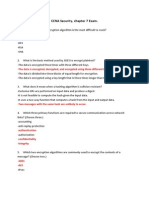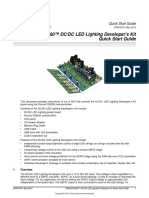Cryptoauthentication™ Faqs: © 2014 Atmel Corporation 1
Cryptoauthentication™ Faqs: © 2014 Atmel Corporation 1
Uploaded by
Manu MathewCopyright:
Available Formats
Cryptoauthentication™ Faqs: © 2014 Atmel Corporation 1
Cryptoauthentication™ Faqs: © 2014 Atmel Corporation 1
Uploaded by
Manu MathewOriginal Description:
Original Title
Copyright
Available Formats
Share this document
Did you find this document useful?
Is this content inappropriate?
Copyright:
Available Formats
Cryptoauthentication™ Faqs: © 2014 Atmel Corporation 1
Cryptoauthentication™ Faqs: © 2014 Atmel Corporation 1
Uploaded by
Manu MathewCopyright:
Available Formats
CryptoAuthentication FAQs
1 2014 Atmel Corporation
Atmel CryptoAuthentication FAQs
Click on the question to jump to the specific answer.
1. I have AES cryptography already, why do I need more?
2. Does Atmel have the highest security rankings (SHA, AES, RSA,
ECC)?
3. Why would I want symmetric algorithms like AES and SHA if the
key only needs to be broken once?
4. How can I justify the additional cost of security in every product?
5. How do I protect the bus between the crypto device and the
microprocessor?
6. How do you encrypt with a one way algorithm like SHA?
7. Is it true that my system isnt secure unless I use a secure micro?
8. How do I protect my valuable software IP?
9. Is there licensing involved with using Atmel devices?
10.Why should I use Atmel chips?
2 2014 Atmel Corporation Security at our Core
1. I have AES cryptography already, so why do I need
anything more? If I am encrypting, isnt that all the
security I need?
AES is an algorithm that scrambles (i.e. encrypts) information. The
scrambled information can then be transferred somewhere else or stored in
encrypted form and will remain unusable until it is unscrambled (decrypted)
into its original form.
AES requires a key to encrypt and the same key to decrypt. Both the
transmitter of the encrypted information and the receiver of it must store
that key and keep that key secret on both sides. If the key is not kept
secret on either side then the information can be obtained by unintended
outside parties, which defeats the whole purpose. So, securely storing the
key is one of the most critical parts of security. The memory where the key
is stored must be able to withstand attacks that try to read the key(s).
Hardware security devices, like Atmels CryptoAuthentication devices, offer
a method of protecting secret keys that restrict access and provide key
generation and management. Hardware security is much stronger then
software based security because of the defense mechanisms that are on
hardware security devices that repel attacks of various types.
3 2014 Atmel Corporation Security at our Core
2. I have heard that security has rankings, and that
they rank something like this: 1) SHA, 2) AES, 3)
RSA, 4) ECC. Does Atmel have the highest ranking?
In essence, security is a function of two main critical factors:
1) The length of the key used by the cryptographic algorithms
2) The mathematical operations that are employed by the cryptographic algorithms.
The strength of security, therefore, depends on both the key size and the
specific algorithms employed. So, any of these algorithms might be stronger
or weaker than any other. Among most cryptographic experts, the following
key sizes are considered to be approximately similar in strength: SHA-256,
AES-128, RSA-3072 and ECC-256. The letters depict the algorithm (e.g.
SHA) and the numbers after the dash represent the length of the key (e.g. -
256).
These important industry standard algorithms are all used in different ways
depending on the application, and many cryptographic systems even use
several types of algorithms together to optimize the benefits of each for
higher security and operational efficiencies (such as speed).
4 2014 Atmel Corporation Security at our Core
3. Symmetric algorithms like AES and SHA use a single
key for all products (e.g. the host and the clients),
so if the key is broken once, it would then be
broken everywhere. Why would I want that?
The secret to understanding cryptography is that operations always depend on keeping
secrets (literally), and that means keeping the secret keys secret. Secure storage of
the secrets (i.e. keys) is what maintains a systems integrity regardless of the
algorithm.
Fortunately, because of clever cryptographic engineering it is not necessary for all
systems using symmetric algorithms to store the exact same key, even though this
may sound counter-intuitive. Using a technique called key diversification each client
in the system can store a unique key that is derived from its unique serial number and
the key in the host (i.e. the root key). During the authentication process with
diversified keys the client sends the host the clients diversified key and the its unique
serial number. The host can then derive the root key from that serial number and that
diversified key and compare that derived root key to the hosts stored root key. If the
stored and derived root keys match then the host knows that the client is real (i.e.
authenticated).
Regardless of the algorithm type, crypto protocol, or system architecture, the best
solution is to prevent the break in the first place by using high security hardware key
storage.
5 2014 Atmel Corporation Security at our Core
4. How can I justify the cost of an additional device to
put security in every system I produce?
Adding security into a system is similar to buying insurance. The cost of a
security breach is analogous to the cost of an accident, fire, earthquake, or
worse. The small cost of adding a crypto device ensures that future
catastrophic costs are not encountered.
Some of the benefits of adding a crypto device are as follows:
Increase revenue that can be lost due to the sale of unauthorized products (e.g.
clones).
Improve revenue by preventing authorized subcontractors from using
unauthorized sales channels (i.e. selling clones in the gray market).
Minimize the cost of warranty support for non-authentic (i.e. cloned) products.
Enforce product and manufacturing licensing agreements to gain royalty income
as agreed to.
Increase product family revenue by allowing only authorized accessories to
operate on an OEMs system.
Conform to regulatory requirements such as HIPAA for medical information
privacy in the US, cross-border medical authentication recommendations in
Europe, and new FDA recommendations in the US for wireless medical device
authentication.
6 2014 Atmel Corporation Security at our Core
5. How do I protect the bus between the crypto device
and microprocessor?
The question often comes up about how to ensure that the communication
between the crypto device and the host MCU is not attacked by a man-in-
the-middle. In order to prevent a hacker from manipulating the bus
between the two chips, the Authentication OK signal (i.e. the Boolean
response) can be uniquely encrypted by the crypto IC.
One way to secure the bus between the crypto IC and MCU is to perform an
authentication on the result of crypto calculation on crypto device (this is
called the CheckMAC function). The idea is to make sure that when the
authentication (i.e. crypto) device puts out the Boolean response (which
means True or False, or one or zero) from the Check MAC operation that
the response cannot be tampered with.
The following paragraph explains in detail how that is done on a technical
basis. However, the simple point here is that the Atmels
CryptoAuthentication devices contain a built-in mechanism to prevent an
attack on the bus between the device and the MCU by effectively encrypting
that communication. (see next page)
7 2014 Atmel Corporation Security at our Core
5. How do I protect the bus between the crypto device
and microprocessor? (cont)
All the Atmel devices have a method of protecting the single Boolean bit
that comes from the authentication chip to the microprocessor. It involves
using the second key that is both stored in the CryptoAuthetication device
and compiled into the code. After the successful completion of the
CheckMAC operation, the second secret is copied into the TempKey
register. Then the MCU sends over a unique number (for example, time of
day), which is then combined with that second secret using SHA and
returned to the MCU.
The software on the MCU does the same combination using the compiled
secret to see if it agrees with the result from the authentication device. This
is beneficial, because it means that you cannot just put a simple switch in
the wire between the two and always send a 1 (i.e. True).
The Atmel cryptographic ICs can also be set up to implement a secure boot
with any MCU. In this mode the devices confirm the authenticity of
downloaded code.
8 2014 Atmel Corporation Security at our Core
6. How can you encrypt with a one way algorithm like
SHA, and isnt XOR weak?
Many encryption algorithms like DES and AES use the XOR function as a key part
of their implementation. Those algorithms use a secret key to produce code that
is XORed with the data in order to encrypt or decrypt that data. The secrecy of
the encrypted data depends upon how well the crypto algorithm mathematically
scrambles that code, and not upon the strength of the XOR function itself.
Hash algorithm-based devices (such as the ATSHA204) use the SHA256
algorithm in the same way to implement an encrypted transport of data between
the crypto device and a microprocessor.
During an encrypted read operation the crypto device uses a random number
that is hashed with an internal secret (i.e. the secret key) to create a result (i.e.
a hash value or digest). That hash value (i.e. digest) is then XORed with the
value to be sent out of the device. (In other words, to encrypt the plaintext, the
plaintext is XORed with the hash of the secret key and a random number.) When
that encrypted data is received outside of the crypto device, the receiver will
need to know the secret (i.e. secret key) that was used in order for that receiver
to reproduce the devices internal value that he or she will XOR with the received
encrypted data to mathematically reconstruct the plaintext. (see next page)
9 2014 Atmel Corporation Security at our Core
6. How can you encrypt with a one way algorithm like
SHA, and isnt XOR weak? (cont)
Similarly, on an encrypted write operation the chip inserts data based on
the XOR of the internal calculated result. The encrypted data sent to the
device should be calculated using the same internal secrets or the chip will
not contain the expected value.
Since a completely new random number is created for each and every
encrypted transport, and because the hash of that random number with the
secret key is used as the XOR code, then breaking such an encrypted
transport would require actually breaking the SHA-256 algorithm itself or
obtaining the secret key.
10 2014 Atmel Corporation Security at our Core
7. I have heard that my system isnt secure unless I
use a secure micro, is that true?
Secure Microprocessors are a great solution if your entire system can be
implemented inside the provided resources of the secure micro and the cost
point of the product is appropriate for the system.
For todays high performance systems, high-end microprocessors with
external expandability or special purpose hardware are required for most
solutions. So, secure microprocessors are typically used as a separate
companion device to the system MCU. The security challenges then
becomes two-fold: 1) Coupling the secure micro with the unsecure
operations of the high performance MCU, and 2) Protecting the bus between
the two.
The best choice today to address those two issues is using a specialized
crypto device (like Atmels CryptoAuthentication) or a secure micro. One
very important point is that a secure device is only as good as the
protection of the stored secrets (i.e. keys) in a specialized crypto key
storage device or in a secure MCU. (see next page)
11 2014 Atmel Corporation Security at our Core
7. I have heard that my system isnt secure unless I
use a secure micro, is that true?
Special purpose Cryptographic IC devices (like CryptoAthentication) focus
solely on secure authentication and key storage, and as a result they can be
the more cost effective choice, and often far more secure.
The security functionality of a dedicated hardware authentication device is
carefully tested and verified by the manufacturer (e.g. Atmel), so the
system designer does not need to worry about bugs that could be exploited
by attackers. In addition, with a hardware approach, the system designer
does not need to be concerned about future software updates of the
software-based solution that can later expose a security weakness.
12 2014 Atmel Corporation Security at our Core
8. How do I protect my valuable software IP?
The only way to fully protect the system software is to use a secure (i.e. smart card
based) microcontroller and store the entire system code within the device. In that way
it cannot be read, copied, or modified by an attacker. However, due to cost and other
concerns, this will not be an acceptable solution for most systems. On the other hand,
a specialized cryptographic authentication IC can provide excellent protection at a low
cost.
In order to stop others from copying the system firmware and producing duplicate
products (i.e. clones), a crypto IC can be employed to match the firmware to
legitimate products. Authorizing firmware can be done by sending challenges to the
cryptographic IC regularly during normal operation and then checking for the correct
response. If a system is build doesnt include a correctly programmed crypto IC, the
firmware will fail to operate, thus protecting against cloning.
If, in the above scheme, the firmware is updated on a regular basis and new challenge-
responses are incorporated into the system, it becomes very difficult for a hacker to
analyze the firmware and remove the authorization checks. If a remote connection is
available, implementing some of the challenges randomly from a trusted backend
server can make this nearly foolproof. (see next page)
13 2014 Atmel Corporation Security at our Core
8. How do I protect my valuable software IP?
Processors like the Atmel ARM9 devices include an on-chip boot ROM. This
ROM can be programmed to use a crypto IC to check a firmware signature
stored in the external flash prior to executing that program. If unauthorized
modifications have been made to the operating program, it will be
immediately detected and system operations can be interrupted.
When system architects are looking to protect sensitive algorithm, data, or
protocols, the same secure boot methodology can be used to decrypt the
encrypted program module stored in the external flash. The decryption key
can be stored in the crypto IC since there is often no secure storage in the
system processor.
14 2014 Atmel Corporation Security at our Core
9. Is there licensing involved with using the Atmel
devices?
The cryptographic algorithms used inside Atmel Crypto devices are industry-
standard and approved algorithms that do not require paying a license fee
to Atmel or any third party.
In addition, Atmel offers communication layer source code free of charge for
users to employ in any way without royalty.
15 2014 Atmel Corporation Security at our Core
10. Why should I choose Atmel CryptoAuthentication
chips for my next design?
Atmel chips are designed from the ground up to provide an ultra-high level
of hardware security. Atmel is now beyond the third generation of devices
that contain years of high security device making experience and know-
how. Some of the benefits that accrue to the Atmel devices are noted
below:
Atmel uses proprietary test methods to eliminate test and probe access
points
Other chips use standard layout methods, but Atmel implements a
serpentine active metal shield over the entire device preventing probing of
internal secret nodes by providing a physical barrier and by detecting and
acting upon attempted attacks.
Atmel chips use the SHA-256 and ECC algorithms to ensure a long system
life. CRC based systems cannot stand up to modern cryptanalysis and SHA-
1 is no longer recommended for new system use by the US government.
(see next page)
16 2014 Atmel Corporation Security at our Core
10. Why should I choose Atmel CryptoAuthentication
chips for my next design?
Few authentication chips include a random number generator, forcing the
system to use weak methods to prevent replay attacks. Atmel devices
include a multi-level FIPs level random number generator on-chip for the
highest quality output.
Atmel takes great care to analyze all possible input conditions to ensure
that faulty or aggressive input sequences will never result in the loss of
secret data.
Many companies have the ability to design a straightforward digital device.
But Atmel includes environmental tampers to prevent operation outside the
specification range, encrypts internal busses to prevent emissions attacks,
controls timing to prevent timing attacks, uses an internal clock generator
to prevent over-clocking, and provides many other security features.
17 2014 Atmel Corporation Security at our Core
Security at our Core
For more information on our security products, log on to
www.atmel.com/security
18 2014 Atmel Corporation
2014 Atmel Corporation.
Atmel, Atmel logo and combinations thereof, Enabling Unlimited Possibilities, and others are registered trademarks or trademarks of Atmel Corporation or its subsidiaries. Other terms and product names may be trademarks of others.
Disclaimer: The information in this document is provided in connection with Atmel products. No license, express or implied, by estoppel or otherwise, to any intellectual property right is granted by this document or in connection with the sale of Atmel
products. EXCEPT AS SET FORTH IN THE ATMEL TERMS AND CONDITIONS OF SALES LOCATED ON THE ATMEL WEBSITE, ATMEL ASSUMES NO LIABILITY WHATSOEVER AND DISCLAIMS ANY EXPRESS, IMPLIED OR STATUTORY WARRANTY RELATING TO
ITS PRODUCTS INCLUDING, BUT NOT LIMITED TO, THE IMPLIED WARRANTY OF MERCHANTABILITY, FITNESS FOR A PARTICULAR PURPOSE, OR NON-INFRINGEMENT. IN NO EVENT SHALL ATMEL BE LIABLE FOR ANY DIRECT, INDIRECT, CONSEQUENTIAL,
PUNITIVE, SPECIAL OR INCIDENTAL DAMAGES (INCLUDING, WITHOUT LIMITATION, DAMAGES FOR LOSS AND PROFITS, BUSINESS INTERRUPTION, OR LOSS OF INFORMATION) ARISING OUT OF THE USE OR INABILITY TO USE THIS DOCUMENT, EVEN
IF ATMEL HAS BEEN ADVISED OF THE POSSIBILITY OF SUCH DAMAGES. Atmel makes no representations or warranties with respect to the accuracy or completeness of the contents of this document and reserves the right to make changes to
specifications and products descriptions at any time without notice. Atmel does not make any commitment to update the information contained herein. Unless specifically provided otherwise, Atmel products are not suitable for, and shall not be used in,
automotive applications. Atmel products are not intended, authorized, or warranted for use as components in applications intended to support or sustain life.
19 2014 Atmel Corporation
You might also like
- Encryption in ASEDocument6 pagesEncryption in ASEkethelnegiNo ratings yet
- Basic Introduction of BioprocessDocument8 pagesBasic Introduction of BioprocessRavenSkullNo ratings yet
- MA5616 Configuration Guide (V800R307C00 - 01)Document306 pagesMA5616 Configuration Guide (V800R307C00 - 01)Lerner Mapurunga100% (1)
- Doc8184 PDFDocument9 pagesDoc8184 PDFlumix345-web1802No ratings yet
- Article 2113Document16 pagesArticle 2113Jerry C GanNo ratings yet
- Security KernelsDocument7 pagesSecurity KernelsDA DrawcordNo ratings yet
- CryptographyDocument7 pagesCryptographySameer KumthekarNo ratings yet
- CSE Instructor Materials Chapter41Document27 pagesCSE Instructor Materials Chapter41qweengh177No ratings yet
- If You Have To Both Encrypt and Compress Data During Transmission, Which Would You Do First, and Why?Document20 pagesIf You Have To Both Encrypt and Compress Data During Transmission, Which Would You Do First, and Why?Pallavi BhartiNo ratings yet
- 3.1 Key ManagementDocument17 pages3.1 Key ManagementLuis Carlos Ramos RosasNo ratings yet
- C036 ICC Practical 8Document11 pagesC036 ICC Practical 8Kylo RenNo ratings yet
- Network SecurityDocument11 pagesNetwork SecurityAshu ChauhanNo ratings yet
- Cryptography & Network Security: Institute of Road & Transport TechnologyDocument11 pagesCryptography & Network Security: Institute of Road & Transport TechnologymaadhawNo ratings yet
- Info SecDocument6 pagesInfo SecAamna SeeratNo ratings yet
- Instructor Materials Chapter 4: The Art of Protecting SecretsDocument29 pagesInstructor Materials Chapter 4: The Art of Protecting SecretsDewi Ayu LestariNo ratings yet
- Implementation of Aes and Blowfish AlgorithmDocument4 pagesImplementation of Aes and Blowfish AlgorithmInternational Journal of Research in Engineering and TechnologyNo ratings yet
- Unit 2-1Document45 pagesUnit 2-1suryarjun23No ratings yet
- Ch8 CryptologyDocument18 pagesCh8 Cryptologycy.sky.pangNo ratings yet
- Atvaultic460 RDocument30 pagesAtvaultic460 RDaniela Cardenas LuboNo ratings yet
- Q1. Define Attack and Explain The Types of ThreatsDocument7 pagesQ1. Define Attack and Explain The Types of ThreatsVinod Kumar100% (1)
- Cryptographic Storage Cheat SheetDocument8 pagesCryptographic Storage Cheat SheetRyuNo ratings yet
- Chapter TwoDocument18 pagesChapter TwoGeleta SafoyiNo ratings yet
- NSC Unit - 2 - 221218 - 100752Document25 pagesNSC Unit - 2 - 221218 - 100752SurenderNo ratings yet
- Computer Security, Also Known As Cyber Security or IT Security, Is The Protection of ComputerDocument4 pagesComputer Security, Also Known As Cyber Security or IT Security, Is The Protection of ComputerOluwaseun Olarewaju OlatunjiNo ratings yet
- Module 2 - Defence in depth - Cryptographic SystemDocument31 pagesModule 2 - Defence in depth - Cryptographic SystemSarthak GuptaNo ratings yet
- Telnet Behind The Scenes of SSL Cryptography The One That Builds HTTPSDocument7 pagesTelnet Behind The Scenes of SSL Cryptography The One That Builds HTTPSPaul KatemaNo ratings yet
- Work Proposal: To: From: DateDocument4 pagesWork Proposal: To: From: Datesaleem razaNo ratings yet
- Lecture-5 Security DarkDocument35 pagesLecture-5 Security DarkMD. RAKIB HASSANNo ratings yet
- CISSP-5Document21 pagesCISSP-5Ghajini SanjayNo ratings yet
- CISSP CryptographyDocument1 pageCISSP Cryptographyonlysubas100% (1)
- Implementing Secure Boot With The Atmel ATSHA204Document10 pagesImplementing Secure Boot With The Atmel ATSHA204m.k.rameshkumar1No ratings yet
- 02 - Basics of Security and CryptographyDocument16 pages02 - Basics of Security and CryptographyAbhinav OliNo ratings yet
- Contoh Proposal Usaha WarnetDocument10 pagesContoh Proposal Usaha WarnetRayanQardhafiNo ratings yet
- 05.best PracticesDocument22 pages05.best PracticesNURRUL ISMAILNo ratings yet
- CC (All in One) - 67Document1 pageCC (All in One) - 67Abdur RobNo ratings yet
- WP Encryption En-Lesson 6Document7 pagesWP Encryption En-Lesson 6LDB2No ratings yet
- U2Document19 pagesU2ronis27647No ratings yet
- Wireless Mobile SecurityDocument41 pagesWireless Mobile SecurityVishu VishalNo ratings yet
- Ch4 Symmetric EncryptionDocument21 pagesCh4 Symmetric EncryptionNajma baasheNo ratings yet
- Finalq 3Document7 pagesFinalq 3Moazzam ChNo ratings yet
- No Network Is 100Document7 pagesNo Network Is 100AngelDayanaNo ratings yet
- Networ AssignmentDocument44 pagesNetwor Assignmentmargaa bacuraaNo ratings yet
- Ipsec: Tcp/IpDocument12 pagesIpsec: Tcp/IpSaptarshi BhattacharjeeNo ratings yet
- Cryptography and Network Security 20APE0511 MinDocument156 pagesCryptography and Network Security 20APE0511 MinsuryareddychillakuruNo ratings yet
- Computer Crytography-Mit 5114-Take Away 2Document10 pagesComputer Crytography-Mit 5114-Take Away 2JoelNo ratings yet
- CCNA Security Ch07 Quiz AnswersDocument6 pagesCCNA Security Ch07 Quiz Answersdercole69No ratings yet
- Chapter 5 Authentication and Encryption TechnologyDocument34 pagesChapter 5 Authentication and Encryption TechnologyHasniza HarunNo ratings yet
- Paper 41-A Survey On The Cryptographic Encryption AlgorithmsDocument12 pagesPaper 41-A Survey On The Cryptographic Encryption Algorithmsmcselles100% (1)
- Data Security - enDocument12 pagesData Security - enarejei87No ratings yet
- Secure Embedded ProcessorsDocument17 pagesSecure Embedded ProcessorsSimmi JoshiNo ratings yet
- Q3. How Are Cryptographic Algorithms Implemented in Organizations? MoazamDocument9 pagesQ3. How Are Cryptographic Algorithms Implemented in Organizations? MoazamMoazzam ChNo ratings yet
- High Level Security ModelsDocument11 pagesHigh Level Security Modelsm.k.rameshkumar1No ratings yet
- Information SecurityDocument5 pagesInformation Securityseeratawan223No ratings yet
- MIS 601: Information Systems Management: Security and Ethical ChallengesDocument36 pagesMIS 601: Information Systems Management: Security and Ethical ChallengesRohan Sivaramakrishnan IyerNo ratings yet
- CNS 01 PDFDocument19 pagesCNS 01 PDFChirantan SahooNo ratings yet
- Cryptology Assignment 4Document4 pagesCryptology Assignment 4audichyaharshali22No ratings yet
- 1 Introduction To CryptosystemsDocument10 pages1 Introduction To Cryptosystemsaarche027No ratings yet
- Unit 4,5 - Highlighted QNSDocument6 pagesUnit 4,5 - Highlighted QNSG PriyankaNo ratings yet
- Encryption Technology in Information System SecurityDocument5 pagesEncryption Technology in Information System SecurityDilshan NimashaNo ratings yet
- Cns Unit-1Document39 pagesCns Unit-1radhikakummari7No ratings yet
- 2y4tCiWbVRI PDFDocument1 page2y4tCiWbVRI PDFManu MathewNo ratings yet
- User Manual / Century Try PackDocument20 pagesUser Manual / Century Try PackManu MathewNo ratings yet
- Tonehammer Didgeridoo Readme PDFDocument15 pagesTonehammer Didgeridoo Readme PDFManu MathewNo ratings yet
- 8DIO Free Angels Read Me PDFDocument7 pages8DIO Free Angels Read Me PDFManu MathewNo ratings yet
- l12 Skiplists PDFDocument6 pagesl12 Skiplists PDFManu MathewNo ratings yet
- Chapter 19. Meeting 19, Workshop: Recording Session 2: 19.1. AnnouncementsDocument2 pagesChapter 19. Meeting 19, Workshop: Recording Session 2: 19.1. AnnouncementsManu MathewNo ratings yet
- Chapter 18. Meeting 18, Delay and Reverb: 18.1. AnnouncementsDocument8 pagesChapter 18. Meeting 18, Delay and Reverb: 18.1. AnnouncementsManu MathewNo ratings yet
- Diode and ApplicationsDocument36 pagesDiode and ApplicationsManu MathewNo ratings yet
- ISL9R860P2, ISL9R860S3ST: 8A, 600V Stealth™ DiodeDocument8 pagesISL9R860P2, ISL9R860S3ST: 8A, 600V Stealth™ DiodeManu MathewNo ratings yet
- 5mm 4-Pin Tri-Color RGB Diffused Common Cathode Red Blue Green LED Leds Light DescriptionDocument1 page5mm 4-Pin Tri-Color RGB Diffused Common Cathode Red Blue Green LED Leds Light DescriptionManu MathewNo ratings yet
- 5 Piano Exercises For Hand Independence - PianoTVDocument7 pages5 Piano Exercises For Hand Independence - PianoTVManu MathewNo ratings yet
- SMD Led: Product Data SheetDocument14 pagesSMD Led: Product Data SheetManu MathewNo ratings yet
- NTE30115 LED Tri Color 5mm High Bright Red/Green/Blue: FeaturesDocument2 pagesNTE30115 LED Tri Color 5mm High Bright Red/Green/Blue: FeaturesManu MathewNo ratings yet
- TMS320C2000™ DC/DC LED Lighting Developer's Kit Quick Start GuideDocument7 pagesTMS320C2000™ DC/DC LED Lighting Developer's Kit Quick Start GuideManu MathewNo ratings yet
- 5mm Round White LEDDocument10 pages5mm Round White LEDdoofydoo32No ratings yet
- OledDocument25 pagesOledManu MathewNo ratings yet
- Ex Plakat enDocument1 pageEx Plakat enFarshid Ahmadian YazdiNo ratings yet
- TACO Expansion TankDocument20 pagesTACO Expansion Tankenlightened1718100% (2)
- Wolf Safety Lamp Company - Rechargeable TorchDocument3 pagesWolf Safety Lamp Company - Rechargeable TorchPandu BirumakovelaNo ratings yet
- Evolution of Operating System I PDFDocument4 pagesEvolution of Operating System I PDFAngel KaseraNo ratings yet
- Temporal Data Mining: Time Series Analysis and Time-Lag DetectionDocument11 pagesTemporal Data Mining: Time Series Analysis and Time-Lag Detectionsankey124No ratings yet
- Bonga University: Engineering Material (Meng2091)Document32 pagesBonga University: Engineering Material (Meng2091)Mul'isaa JireenyaaNo ratings yet
- Carbon Fiber, Advanced Composite ExplainedDocument4 pagesCarbon Fiber, Advanced Composite ExplainedAlexNo ratings yet
- Concrete Cold JointDocument4 pagesConcrete Cold JointAjayvidyanand SharmaNo ratings yet
- Elements of Roads and Highways by Max Fajardo 2nd EditionDocument2 pagesElements of Roads and Highways by Max Fajardo 2nd Editionjohnnoe delosreyes0% (1)
- Notes On The Diffusion-Type Model For The Longitudinal Mixing of in Flow FluidsDocument9 pagesNotes On The Diffusion-Type Model For The Longitudinal Mixing of in Flow FluidsJesus Moreno CastilloNo ratings yet
- 2500 Nonin Oximeter TroubleshootingDocument2 pages2500 Nonin Oximeter TroubleshootingHector LopezNo ratings yet
- Step MotorsDocument24 pagesStep MotorsHùng ThanhNo ratings yet
- Cable Bus Brochure 2010Document32 pagesCable Bus Brochure 2010freze2978No ratings yet
- TL-WN350G User GuideDocument40 pagesTL-WN350G User GuideUri RmzNo ratings yet
- CPAA Cable Installation Manual-KF CX-5 + KG CX-8Document18 pagesCPAA Cable Installation Manual-KF CX-5 + KG CX-8Viktor XNo ratings yet
- Guide For Visatron Oil Mist Detector Users Version 1.2.3-02Document72 pagesGuide For Visatron Oil Mist Detector Users Version 1.2.3-02RostyslavNo ratings yet
- PIP-LC User ManualDocument31 pagesPIP-LC User ManualPelusaGurmendezNo ratings yet
- EV Seg VP744-5DZ1-04F-M-X555Document62 pagesEV Seg VP744-5DZ1-04F-M-X555memosurf3775No ratings yet
- Ground Floor Plan Second Floor Plan: Proposed Three - Storey Architectural Plan Tuazon, Christine SDocument1 pageGround Floor Plan Second Floor Plan: Proposed Three - Storey Architectural Plan Tuazon, Christine STin TuazonNo ratings yet
- Basic Lab ReportDocument13 pagesBasic Lab ReportHafid Papeda SaguNo ratings yet
- Brosur RomoraDocument43 pagesBrosur RomoraDonie TheaNo ratings yet
- Impact of SCM Practices at Fast Food Restaurants PDFDocument6 pagesImpact of SCM Practices at Fast Food Restaurants PDFAbdulkader TukaleNo ratings yet
- Eemi 2130903Document3 pagesEemi 2130903Dhaval PatelNo ratings yet
- SBC For DummiesDocument51 pagesSBC For Dummiesbknauf7770% (1)
- Leak Off Procedure: Well ControlDocument7 pagesLeak Off Procedure: Well ControlfarajNo ratings yet
- FMDVSPLTR InstructionsDocument5 pagesFMDVSPLTR InstructionsFatosYañezNo ratings yet
- MAC-048HE-02-L High Efficiency Air-Cooled ChillerDocument14 pagesMAC-048HE-02-L High Efficiency Air-Cooled ChillerFranz CorasNo ratings yet
- SAP BASIS Course ContentDocument9 pagesSAP BASIS Course ContentHassan AlzenaryNo ratings yet









































































































